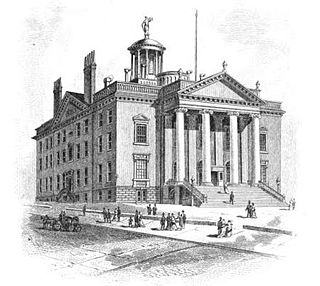Sessions
The Convention met from June 17 to July 26, 1788, at Poughkeepsie, and ratified the U.S. Constitution by a vote of 30 to 27.
The State Legislature met on December 11, 1788, at the Old City Hall in Albany; and adjourned on March 3, 1789.
On January 27, 1789, the Legislature divided the State of New York into six congressional districts, and the first congressional elections in New York were held on March 3 and 4, 1789.
In February and March 1789, the Legislature debated at length "An act for prescribing the times, places and manner of holding elections for Senators of the United States of America, to be chosen in this State" but the Anti-Federalist Assembly majority and the Federalist Senate majority could not agree, and they adjourned without having elected U.S. Senators. Both parties hoped to win the next State election, to be held in April 1789, and agreed to adjourn earlier than usual, leaving it to the new members to find a way out of the deadlock.
The 1789 United States Senate election in New York was held in July 1789 to elect two U.S. senators to represent the State of New York in the United States Senate. It was the first such election, and before the actual election the New York State Legislature had to establish the proceedings how to elect the senators.

The 11th New York State Legislature, consisting of the New York State Senate and the New York State Assembly, met from January 9 to March 22, 1788, during the eleventh year of George Clinton's governorship, in Poughkeepsie.

The 13th New York State Legislature, consisting of the New York State Senate and the New York State Assembly, met from July 6, 1789, to April 6, 1790, during the thirteenth year of George Clinton's governorship, first in Albany, then in New York City.

The 14th New York State Legislature, consisting of the New York State Senate and the New York State Assembly, met from January 5 to March 24, 1791, during the fourteenth year of George Clinton's governorship, in New York City.

The 15th New York State Legislature, consisting of the New York State Senate and the New York State Assembly, met from January 5 to April 12, 1792, during the fifteenth year of George Clinton's governorship, in New York City.

The 16th New York State Legislature, consisting of the New York State Senate and the New York State Assembly, met from November 6, 1792, to March 12, 1793, during the sixteenth year of George Clinton's governorship, in New York City.

The 17th New York State Legislature, consisting of the New York State Senate and the New York State Assembly, met from January 7 to March 27, 1794, during the seventeenth year of George Clinton's governorship, in Albany.

The 18th New York State Legislature, consisting of the New York State Senate and the New York State Assembly, met from January 6 to April 9, 1795, during the eighteenth year of George Clinton's governorship, first in Poughkeepsie, then in New York City.

The 19th New York State Legislature, consisting of the New York State Senate and the New York State Assembly, met from January 6 to April 11, 1796, during the first year of John Jay's governorship, in New York City.

The 20th New York State Legislature, consisting of the New York State Senate and the New York State Assembly, met from November 1, 1796, to April 3, 1797, during the second year of John Jay's governorship, first in New York City, then in Albany.

The 21st New York State Legislature, consisting of the New York State Senate and the New York State Assembly, met from January 2 to April 6, 1798, during the third year of John Jay's governorship, in Albany.

The 22nd New York State Legislature, consisting of the New York State Senate and the New York State Assembly, met from August 9, 1798, to April 3, 1799, during the fourth year of John Jay's governorship, in Albany.

The 23rd New York State Legislature, consisting of the New York State Senate and the New York State Assembly, met from January 28 to April 8, 1800, during the fifth year of John Jay's governorship, in Albany.

The 24th New York State Legislature, consisting of the New York State Senate and the New York State Assembly, met from November 4, 1800, to April 8, 1801, during the sixth year of John Jay's governorship, in Albany.

The 25th New York State Legislature, consisting of the New York State Senate and the New York State Assembly, met from January 26 to April 5, 1802, during the first year of George Clinton's second tenure as Governor of New York, in Albany.

The 28th New York State Legislature, consisting of the New York State Senate and the New York State Assembly, met from November 6, 1804, to April 10, 1805, during the first year of Morgan Lewis's governorship, in Albany.

The 40th New York State Legislature, consisting of the New York State Senate and the New York State Assembly, met from November 5, 1816, to April 15, 1817, during the tenth year of Daniel D. Tompkins's governorship, and while John Tayler was Acting Governor, in Albany.

The 42nd New York State Legislature, consisting of the New York State Senate and the New York State Assembly, met from January 5 to April 13, 1819, during the second year of DeWitt Clinton's governorship, in Albany.

The 44th New York State Legislature, consisting of the New York State Senate and the New York State Assembly, met from November 7, 1820, to April 3, 1821, during the fourth year of DeWitt Clinton's governorship, in Albany.

The 45th New York State Legislature, consisting of the New York State Senate and the New York State Assembly, met from January 2 to April 17, 1822, during the fifth year of DeWitt Clinton's governorship, in Albany.




